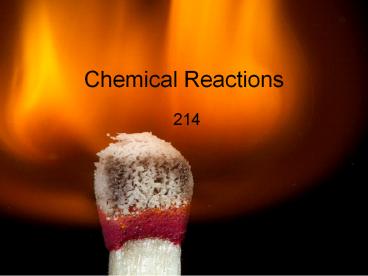Chemical Reactions - PowerPoint PPT Presentation
Title: Chemical Reactions
1
Chemical Reactions
- 214
2
1. What is a chemical change?
- a change in matter that produces one or more NEW
SUBSTANCES with different properties
3
2. What is the difference between physical
changes and chemical changes.
- Physical alters form or appearance
- stampedes stampedes
- Chemical produces a new substance
- stampedes made steps
4
(No Transcript)
5
(No Transcript)
6
3. Describe reactants and products
Chemical Change
- Reactants Products
New substances formed from the reaction
Substances that undergo change
7
4. When does a chemical change occur?
- When chemical bonds break and new bonds form.
8
5. How can you tell if a chemical reaction
occurs?
- Look for clues!
- Change in properties
- Energy change
9
6. Compare the properties of a compound with the
properties of the elements that make up that
compound.
- The properties of the new compound IS DIFFERENT
from the properties of the original elements. - Ex H O H2O
- Ex C H O C12H22O11
- Ex Na Cl NaCl
10
(No Transcript)
11
(No Transcript)
12
(No Transcript)
13
7. How does energy change during a chemical
reaction?
- Chemical reactions usually absorb heat or
liberate (release) heat.
14
8. What is an exothermic reaction?
- A chemical reaction in which energy is released
- liberate or release heat
- Feels warm!
15
9. What is an endothermic reaction?
- A chemical reaction in which energy is taken in.
- absorb heat
- Feels cool!
16
10. What is a chemical equation?
- Chemical symbols and formulas as a short way to
describe a chemical reaction. - _____ _____ _____ _____
- reactants yield products
17
(No Transcript)
18
(No Transcript)
19
(No Transcript)
20
11. What is the law of the conservation of mass?
- During a chemical reaction, matter is neither
created nor destroyed.
21
(No Transcript)
22
Lavoisier
- Determined (among other things) that a rusting
object doesnt lose weight, as everyone had long
assumed, but gains weight an extraordinary
discovery. Somehow, as it rusted the object was
attracting elemental particles from the air. It
was the first realization that matter can be
transformed but not eliminated.
23
- Also, if we were to burn this book now, its
matter would be changed into ash and smoke, but
the net amount of stuff in the universe would be
the same! - - Bill Bryson
24
(No Transcript)
25
12. What does this mean?
- The number of atoms stays the same no matter how
they are arranged. So their total mass stays the
same - Atoms in atoms out
26
13. Why must equations be balanced?
- To satisfy the law of conservation of mass
- A chemical equation must show the same number of
each type of atom on both sides of the equation.
27
14. What are the steps to balancing equations?
- Write the equation
- Count the atoms
- Use coefficients to balance atoms
- Look back and check
28
(No Transcript)
29
Example 1
- HgO Hg O2 (unbalanced)
- 2HgO 2Hg O2 (balanced)
30
Example 2
- Mg HCl H2 MgCl2
(unbalanced) - Mg 2HCl H2 MgCl2
(balanced)































